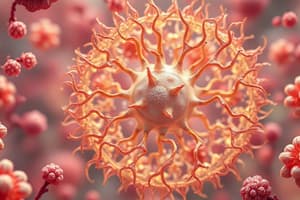Podcast
Questions and Answers
What is a characteristic that all prokaryotes belong to?
What is a characteristic that all prokaryotes belong to?
- Eubacteria
- Archaebacteria
- Algae
- Monera (correct)
Which of the following is a characteristic of Archaebacteria?
Which of the following is a characteristic of Archaebacteria?
- Ability to live in normal environments
- Multicellular organisms
- Presence of peptidoglycan in the cell wall
- Absence of peptidoglycan in the cell wall (correct)
What do Monerans lack?
What do Monerans lack?
- Cell wall
- Cell membrane
- Nucleus (correct)
- Mitochondria
What is unique about the environments in which Archaebacteria live?
What is unique about the environments in which Archaebacteria live?
What is composed of amino acids and sugar?
What is composed of amino acids and sugar?
What is the primary purpose of classification in taxonomy?
What is the primary purpose of classification in taxonomy?
What is the highest rank in the classification hierarchy?
What is the highest rank in the classification hierarchy?
Which classification system is based on physical characteristics?
Which classification system is based on physical characteristics?
What is the most specific rank in the classification hierarchy?
What is the most specific rank in the classification hierarchy?
Which type of classification is based on a single characteristic?
Which type of classification is based on a single characteristic?
How many domains are there in the classification hierarchy?
How many domains are there in the classification hierarchy?
What is the main difference between the Linnaean System and the Phylogenetic System?
What is the main difference between the Linnaean System and the Phylogenetic System?
What is the term for the arrangement of organisms into groups based on their similarities and differences?
What is the term for the arrangement of organisms into groups based on their similarities and differences?
Which rank is below the phylum rank in the classification hierarchy?
Which rank is below the phylum rank in the classification hierarchy?
What is the purpose of the classification hierarchy?
What is the purpose of the classification hierarchy?
Flashcards are hidden until you start studying
Study Notes
Monera
- Lack nucleus and are prokaryotes
- Include all prokaryotes, Archaebacteria and Eubacteria
- Single-celled organisms
- Numerous organisms on Earth
- No cell membrane but have Mitochondria
- Fewer structures, require microscope to see
Archaebacteria
- Ancient bacteria, live in extreme environments
- Prokaryotes, unicellular, no peptidoglycan
- Mostly extremophiles: halophiles, methanogens, thermophiles
- Some are autotrophs, others are heterotrophs
- Lack peptidoglycan, which is made up of amino acids and sugar
Classification in Taxonomy
- Taxonomy is the science of classification
- Involves arrangement of organisms into groups based on similarities and differences
Hierarchy of Classification
- Domain: highest rank, divides life into six domains: Archaea, Bacteria, Eukarya, Chromista, Protozoa, and Fungi
- Kingdom: divides life into six kingdoms: Animalia, Plantae, Fungi, Protista, Chromista, and Monera
- Phylum (or Division in Plantae): divides kingdoms into more specific groups
- Class: divides phyla into smaller groups
- Order: divides classes into smaller groups
- Family: divides orders into smaller groups
- Genus: divides families into smaller groups
- Species: most specific rank, defines a unique group of organisms
Classification Systems
- Linnaean System: developed by Carolus Linnaeus, uses hierarchical classification based on physical characteristics
- Phylogenetic System: focuses on evolutionary relationships between organisms, using characteristics such as DNA and fossil records
Types of Classification
- Artificial Classification: based on a single characteristic, such as flower color or leaf shape
- Natural Classification: not mentioned in the text, but implied as the alternative to artificial classification
Studying That Suits You
Use AI to generate personalized quizzes and flashcards to suit your learning preferences.




